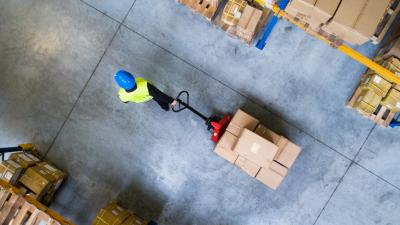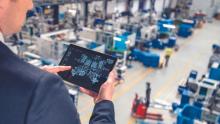- Support portal
- Evaluation Kits and partner products
u-blox Support
- Product documentation
Documentation
- Investor relations
Investor relations
Insights
|
01 Oct 2021
Getting started with RTLS
RTLS (real-time location systems) explained in 6 minutes (or a little more, if you want all the details).

Imagine two competing businesses. The first has real-time data on its moving parts: people, parts, products, etc. The second one doesn’t. It isn’t hard to guess which of the two can operate more efficiently.
As the pace of business picks up, knowing where people and assets are real time is gaining importance. At the same time, technological progress is making ever more sophisticated RTLS solutions ever more accessible to businesses both large and small.
In this article, we’ll look at what real-time location systems (RTLS) are, the benefits they bring, and the technologies they rely on. We’ll explore important points to consider when implementing RTLS systems. And, finally, we’ll look at how u-blox can help you get started on your RTLS journey.
What is a real-time location system (RTLS)?
Real-time location services use sensing, wireless communication, and the cloud to determine the location of tagged “things” – shipments, vehicles, people, pets, and a wide variety of industrial tracking applications – and make the data available to authorized users on local computers or via a cloud platform.
RTLS solutions serve a spectrum of use cases with an equally broad range of constraints:
- Accuracy: From the neighborhood to the centimeter level
- Update rate: From daily to several times per second
- Coverage: Open sky? Indoors? Underground? Global?
- Bandwidth: From a few bytes of data per day to a continuous data stream
- Power autonomy: From days to years.
- Security: From elementary to ultra-robust.
- Deployment architecture: From one hop to the internet to two or more hops (via a gateway).
Solutions deployed in remote locations may, for instance, require several months of power autonomy. Those used in transportation hubs or fast-moving production lines, on the other hand, may benefit from frequent updates. And when high-value assets are involved, heightened security may become indispensable.
RTLS use cases
Real-time location services are already well established in a number of use cases, and their footprint is predicted to grow further in coming years as the technology becomes smaller, more accessible, and more tightly integrated into operations.
RTLS in Healthcare
In hospitals, a sizable fraction of working hours are spent looking for medical equipment, putting additional pressure on an already strained system. RTLS in hospitals can help rapidly locate beds and medical equipment and potentially also doctors, staff, and patients.
Warehouse automation
RTLS systems benefit warehouse automation to automate inventory management, stockkeeping, and locating goods on shelves.
Shipping and logistics
Real-time location services give companies vital insights into all aspects of the supply and distribution process. In addition to improving supply chain management, companies can use data provided by their RTLS system to mitigate bottlenecks and streamline their processes and remotely monitor the handling of their shipments, improving the quality of their products.
Fleet management
RTLS systems help fleet managers keep track of their vehicles, whether they are trucks, taxis, rental cars, or shared vehicles. Micromobility solution providers, such as those offering shared e-scooters, are increasingly using RTLS technologies with high precision positioning to enforce compliance with local regulations, such as sidewalk driving bans.
Transportation hubs
Transportation hubs such as airports and railway stations can benefit from RTLS technology to track baggage handling trailers, passengers with special needs, ground staff, and passengers. Data collected can be analyzed to detect and address operational weaknesses and offer an overall improved travel experience.
RTLS technologies
Real time location systems are typically made up of three components: RTLS tags, infrastructure, and software. The performance and functionality of solutions depend on the specific technological choices made in the development of the RTLS solutions.
- RTLS systems using RFID technology locate “things” carrying tags when they pass near a fixed reader, which then sends information about the event to the server.
- Bluetooth RSSI (received signal strength indicator) is used to implement a real time location system in indoor environments. Bluetooth beacons deployed within the monitored area “listen” for signals emitted by Bluetooth tags to determine if the tagged objects or people are within range of the Bluetooth signal, offering “room-level” positioning accuracy.
- Like Bluetooth RSSI, Wi-Fi beacons can be used to detect proximate Wi-Fi RTLS tags delivering “room-level” accuracy. Alternatively, time-of-flight methods can be used to more accurately nail down the location of moving assets.
- Cellular 3G and 4G LTE technology offer coarse position information using cellular network fingerprinting, in which devices detect the cellular base stations in their vicinity and compare them against a global database of fingerprints that have been mapped to geographical locations. Higher accuracy 3G and 4G LTE real time tracking solutions that depend on varying combinations of fixed and mobile network infrastructure are also available today, with more to come as 5G deployments increase their footprint.
- GNSS-based RTLS systems rely on GNSS receivers that determine their position by measuring the time it takes GNSS satellite signals to reach them from orbit. Because GNSS signals are too weak to penetrate through walls and into buildings, service is only available outdoors.
- Ultra-wideband technology and Bluetooth high precision indoor positioning based on Bluetooth direction finding are two technologies that are capable of delivering sub-meter location accuracy.
- RTLS tags may include other sensors to gather additional information on the tracked assets. Positioning modules featuring inertial sensors detect when assets are dropped or complement satellite-based positioning when GNSS signals are interrupted. Similarly, temperature sensors detect temperature excursions that may harm sensitive shipments.
To make location data available to their users, real time location systems need a data pipe to the internet. Outdoor real time tracking solutions such as those based on GNSS are best served with some form of cellular communication that is optimized for low power and maximum coverage, such as LTE Cat 1 or LTE-M.
Getting started with u-blox
Tapping into the benefits RTLS technology can bring to your business may appear challenging at first. At u-blox, our portfolio of solutions and services covers all of the technological building blocks required to build RTLS systems.
In addition to a vast selection of GNSS solutions and cellular communication modules, our offering includes high performance combo modules delivering unthrottled GNSS and cellular communication performance out of a single component – ideal for compact RTLS solutions with demanding performance requirements. Our combo modules are presented in more detail in a recent white paper.
Our short range solution offering includes the components required to build high precision indoor positioning solutions based on Bluetooth direction finding. More information is available in a dedicated white paper on how to get started with Bluetooth indoor positioning technology.
We have developed a suite of location services that bring further benefits to GNSS-based RTLS deployments.
- AssistNow saves power by shortening the time it takes to achieve a position fix using GNSS.
- CellLocate using cellular network fingerprinting for a coarse position estimate when GNSS is unavailable.
- CloudLocate delegates the position estimate from the GNSS receiver to the cloud for ultra low power use cases that do not depend on continuous tracking.
- PointPerfect integrates GNSS augmentation data to achieve centimeter-level accuracy in seconds.
u-blox communication services deliver data from IoT devices to the enterprise cloud with minimal overhead, making them ideal of power and bandwidth-constrained IoT deployments.


